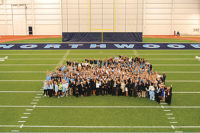While not a parishioner of Zion Episcopal Church in Oconomowoc, Wis., Rich Schulte Jr., knows the intricacies of the approximately 15,000-sq.-ft. place of worship.
Schulte, vice president of Oconomowoc-based Schulte Heating, has attended events at the 127-year old church, including sending his own children for music lessons. Most recently, and importantly, Schulte, an Oconomowoc native, oversaw the replacement of the Zion Episcopal’s outdated and inefficient boiler system.
In September 2015, the Zion Episcopal Board of Directors was very concerned that it would not be able to provide its congregation a comfortable setting during the tough Wisconsin winters. The original four boiler setup was down to two working boilers — one of which was leaking.
“They were afraid they would not be able to get through the heating season,” Schulte recalls of the initial meetings. “And they would not have. They were not happy with what they had and knew the end was near.”
Schulte — who holds a mechanical engineering degree from Marquette University in Milwaukee — submitted a proposal to Zion Episcopal which called for the removal of all four boilers and the installation of two Weil-McLain high-efficiency Evergreen boilers. The board was very involved in understanding what was going to be installed at its church, which pleased Schulte.
“I was happy (with their involvement),” Schulte says. “There was a lot of back-and-forth and explaining what would be going on. What we had to offer was what they were looking for.”
Linda Georgeson, the senior warden at Zion Episcopal, was the point person Schulte worked with during the project. Georgeson, a retired lawyer, started researching all the routes the church could have taken for the boiler replacements. She scoured the Internet regarding industry materials on what would work best at Zion Episcopal.
“I was building a library of information,” she notes.
New and improved
Zion Episcopal’s original heating systems consisted of four 199 MBH boilers installed in the early 2000s. The four units were a $26,000 donation, according to Georgeson, and still were under warranty. Yet, Georgeson and the board decided to go in a different direction, because of the copious amounts of issues the system had despite being “state-of-the-art” when originally purchased.
“We invested a lot of time researching, evaluating commercial boilers and reviewing the proposals we received,” Georgeson says. “In an open meeting of the church, we charted cross comparisons of all the different units, the associated costs and warranties, and who would handle installation.”
Churches typically are a challenge to heat, according to Schulte, because of the large open spaces that can be used sparingly throughout a season. Zion Episcopal was an added challenge because it is mostly a stone building that was built in 1889.
“The building holds heat well, but it also holds cold well,” Schulte notes. “The whole building is mostly unused the majority of the week. They will turn it down to 60° F then get it up to 68° when in use. If it is really cold out, it takes a while to heat up.”
In the end, Schulte — who has done other jobs at Zion Episcopal, including boiler work in its rectory — and the Weil-McLain Evergreen boilers got the go-ahead. In place of the four existing boilers, Schulte installed a 299 MBH and a 399 MBH as a multiple boiler system using the Modbus communication feature. With this install, a master boiler controls the modulation and sequencing of the two units on the network, achieving the wanted system supply temperature.
Schulte felt comfortable with the Evergreen boilers because of the design and comfort level he has with its heat exchanger. “That heat exchanger has been used in other products for years and years,” he points out.
Schulte says he is a fan of boiler controls in general and loves working with the built-in controls on the Evergreen. Those controls were critical for Zion Episcopal because the church only heats the entire building one day per week (Sunday) during the heating season. The rest of the building is set up into five zones that can be switched on when needed by Georgeson or anyone else.
“It’s easy as pie,” Georgeson says of working the boilers’ controls.
In the beginning of the project and long after installation was finished, Schulte made it a point to maximize the efficiencies of the Evergreen boilers at Zion Episcopal. “We started with the wizard setup option, changed a couple of setting and the boilers would run,” he explains. “Then I went back, I would stop on my way into work to tweak this or that, and see what difference it made. You can get in quite deep on the controls if you want to.
“If you get aggressive with some of the controls to keep the water temperatures as low as you can, you get the most efficient system. The boost time feature allows you to get aggressive, but if you get too aggressive it will save your bacon.”
Thanks to Schulte’s tinkering, Zion Episcopal is not struggling to get heat on a cold day. For example, on a 20° winter day in Oconomowoc — where the church sits next to the town’s Lake Fowler — the system is set up to have 168° water circulating. But, if the boilers are not catching up and the system is still calling for heat, the boiler will modulate up a little higher and deliver warmer water.
“That gets us over the hump,” Schulte says. “Then the system will walk back down again.”
Upon analyzing the facility and the original design, Schulte notes the system was oversized for Zion Episcopal’s needs. Schulte says even with one boiler modulated down to the lowest possible temperature, it was not close to what the church needed.
Now, the 95% AFUE boilers allow for Schulte to significantly downsize the overall load.
“There are five heating zones and they are not equal in size,” he notes. “They are not equally distributed. Today, we can get pretty darn close to that smallest load. And we can ramp up all the way for the largest load needs.”
Break on through
The Evergreens also were critical to Zion Episcopal because Schulte and his team had to break through the stone walls to install 4-in., PVC pipe for venting.
“We were looking for something that would not make a giant hole in the building,” he says. “They had existing flues that were not in good enough shape to use over again. This way we could abandon all that stuff.”
After the installation was complete, Schulte was thankful for the in-unit data-logging processes the boilers features. During one of the initial checks of the application an error was recorded that stumped Schulte for a bit.
“If there is any kind of error, even if the error doesn’t shut off the boiler, the unit logs and timestamps it,” he says. “I went in and checked the log. We had a couple situations where a vent-pressure switch said something was blocking it.”
It turns out the placement of the PVC-venting pipe would allow the system to catch so much wind coming off the lake it would force the vent pressure switch to open. After doing some troubleshooting, Schulte and his team did a slight redirection of the PVC pipes to avoid any other issues.
“We found that because we looked at the data logs,” Schulte says. “That was helpful. It’s pretty intuitive the way the controls are laid out.”
Another positive for Schulte and Zion Episcopal was the original piping in the mechanical room being able to be reused with the new boilers. Schulte did add some new copper pipes and a pair of new Taco 0013/14 circulators and Isolator valves from Webstone Valve for the application, which created more space for Georgeson and Zion to utilize if they would like to.
There is still some more work that could be done, according to Schulte, but that will have to wait.
“I would still like to go back and redo a little bit of it, eliminate some of the things they do not need anymore,” he says.
Georgeson commends Schulte for the installation and the continual work put in at Zion Episcopal. “He is resilient,” she says.
She also has been satisfied with the savings the church has received off its utility bill over the past 10 months.
“We expected reasonable savings and we are receiving them,” she says.
From start to finish, Schulte was proud of the system at Zion Episcopal and it came together because of a true team effort. “I was pleased with the way this job worked out from the proposal stage to completion,” he says. “The church board did its homework and recognized the combination of Evergreen boilers and our installation plan was the best choice.”
This article was originally titled “Praise worthy” in the July 2016 print edition of PM Engineer.







